Ducati Monster 1200S (2017) review
The Ducati Monster 1200S (2017) is the most tech-packed Monster yet, but is it still 'unmistakably Monster'?

Ducati Monster 1200S (2017): Introduction
There are a tonne of bikes that I’ve never ridden and until very recently, I’d never swung a leg over a Ducati Monster.
Oh, the shame of it, after all, the Monster is one of the iconic Ducatis and a bike that has every right to stake a claim as the originator of the sports naked class.
It’s a class that’s come a long way since Ducti first introduced the M900 in 1993. Right now, it’s pretty unhinged. In fact, the term ‘sports naked’ has long been ditched in favour of ‘super naked’ in line with how Ducati Monster and its peers have become increasingly lairy.
Now, big naked bikes are more powerful, sophisticated and focused than even before. Although they’re still a superb option if you want an exciting bike for weekend scratching, the odd track day and a fun time, they’re also more serious and capable than ever.
The new Monster 1200 and 1200S is no exception to this change and for 2017 Ducati has given it more power, a sophisticated electronics package from the 1299 Panigale, and a redesign that includes a shorter tail section and slimmer tank. Ducati says this Monster has been given more than a facelift, but that it's still 'unmistakably Monster' and seeing as this is my introduction to the Monster, I hope they're right.
The increase in power and torque comes courtesy of the latest version of the liquid-cooled 1198.4cc Testastretta 11° L-twin engine, which has a been given new throttle body inlet ducts and has had its compression ratio increased. As a result, the 2017 Monster 1200 and 1200 S now punt out 150hp and 93.1lb/ft torque; that’s 5hp more than the previous Monster 1200S and just 10hp less than the Monster 1200 R.

That means it’s almost the least powerful European super-nekkid as it makes 10hp more than the Triumph Speed Triple but is 15hp down on the new BMW S1000R, 25hp down on the Aprilia Tuono V4 1100, while new KTM 1290 Super Duke R puts out a ridiculous 177hp. However, with 93.1lb/ft, the Monster 1200 makes a bit more torque than the BMW (which makes 84lb/ft), Aprilia (which makes 89lb/ft) and Triumph (82lb/ft).
The Monster 1200S weighs 185kg dry and during the presentation, I was told that the standard model is 2kg heavier.
The S model is quoted as weighing 200.5kg wet with no fuel, so with a full tank of unleaded, it’s going to be heavier than the 205kg fully-fuelled and ready-to-rock BMW. Aprilia says the dry weight of the Tuono is 184kg. Dry weights for the Super Duke R and Speed Triple R are 195kg and 192kg respectively but it’s difficult to accurately compare these as manufacturers aren’t often clear about what/how they class wet and dry weights.
But enough with the numbers; I wasn’t reciting spec sheets to myself once on the move and ‘It’s lacking a bit of power’ wasn’t a phrase that came to mind once I’d hit the road.
Ducati Monster 1200S (2017): Engine
The engine has bags of smoothly delivered torque and pulls like Wayne Rooney in an old people’s home. The torque makes itself noticeable from 3,000rpm but between 6 and 10,000rpm is where this Monster become most savage as it surges forward with the front wheel hovering over the tarmac (or floating above it, depending on the wheelie control).

Without doubt, the Monster 1200’s torque is king, and although 150hp isn’t to be sniffed at, punching out of bends and using the bike’s considerable midrange shove always put the biggest smile of my face because that relentless shove is so accessible and alluring. When you add in the peachy fuelling and excellent throttle response in all riding modes (Sport, Urban, Touring), the Monster 1200’s engine is hard to fault.
Complimenting the reinvigorated engine is a suite of electronics from the 1299 Panigale, so the 2017 Monster 1200S has cornering ABS thanks to the addition of an IMU. It also boasts a quickshifter and auto-blipper as standard (a first for the Monster), along with eight-stage traction and wheelie control, plus three levels of ABS intervention.
On the damp switchback roads in the hills north of Monte Carlo, the traction control performed superbly. With a lot of the roads being bumpy, dusty and having a sheer drop on one side, I wasn’t pushing my luck with the traction control but on the couple of occasions where I detected it working as I exited wet hairpins, I could feel it doing so with the utmost grace and subtley to keep the rear tyre (and overzealous rider) in check.
If you’ve not used a quickshifter before, you’ve got to give one a go; they’re a lot of fun and the Monster 1200S’s Ducati Quickshifter (DQS) is no exception. Smooth clutchless changes up and down the box are the order of the day, although it definitely worked best for me when I wasn’t pootling around. In town I preferred to change gear with the clutch as meant I could avoid the occasional clunkiness of the quickshifter’s performance at low speed.
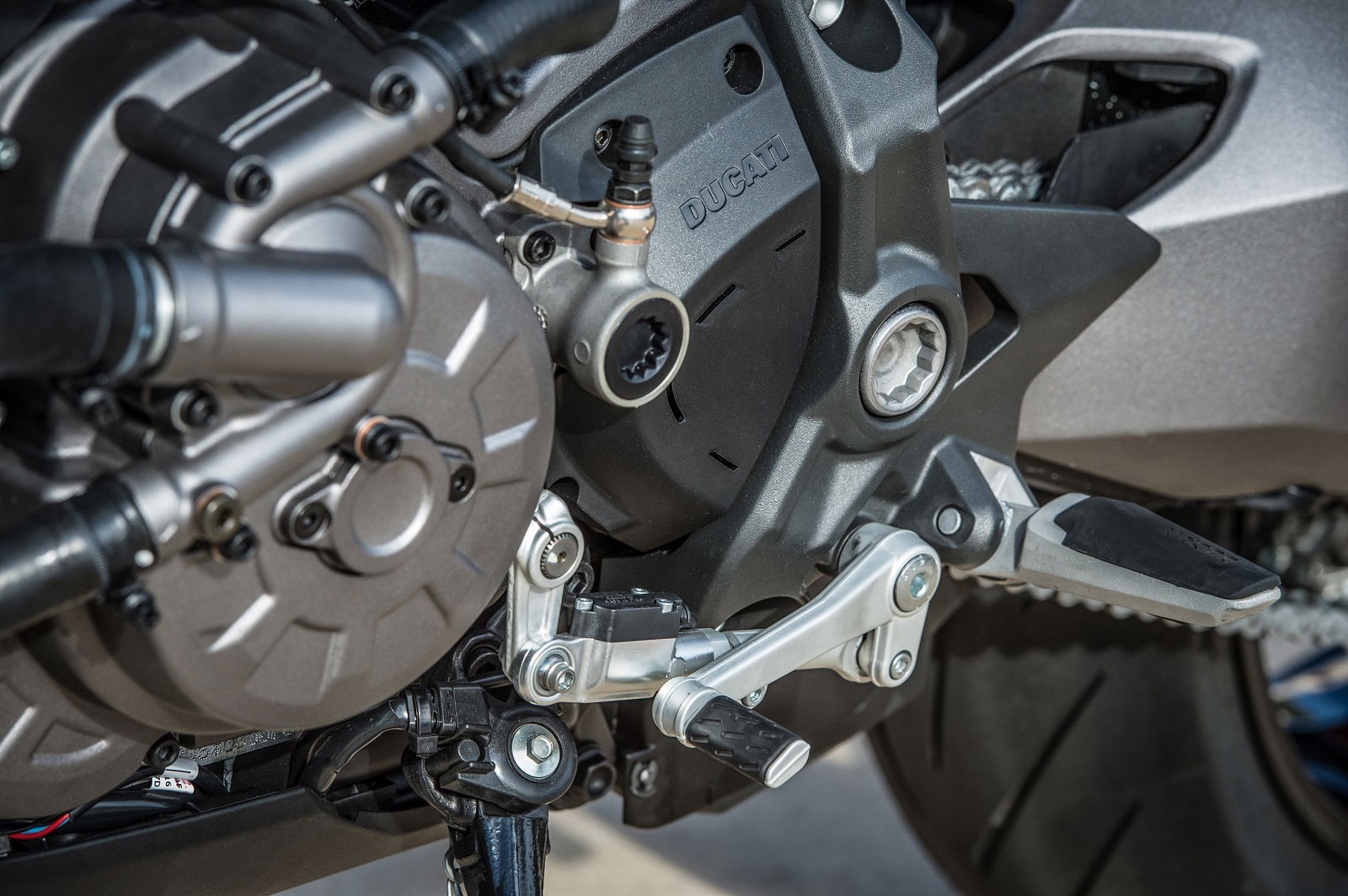
The DQS is fun because it makes riding in attack mode that little bit easier. It gave me more time to think, to plan and assess because I never had to worry about using the clutch or blipping the throttle (not that I needed to with a slipper clutch), instead I was free to focus on braking and acceleration and that makes the ride more precise and enjoyable, and makes the bike’s perrormance more accessible. While on the test ride, I had two of occasions when I was riding fast and got a few up-shifts that were laggy – like the ignition had been cut for a moment too long. Otherwise, the DQS is brilliant, although I think it requires a more positive-than-normal shift between first and second gears, otherwise it’s easy to hook neutral in either direction.
Setting for the electronics are all altered using the excellent, crisp, clear colour TFT dash screen and the controls on the left switchgear. When on the move, all the crucial information is easy to see at a glance. Changing between ride modes and altering individual ride mode settings (like traction control, wheelie control, ABS and quickshifter operation) is intuitive and easy and you setting are stored for the next time you ride.
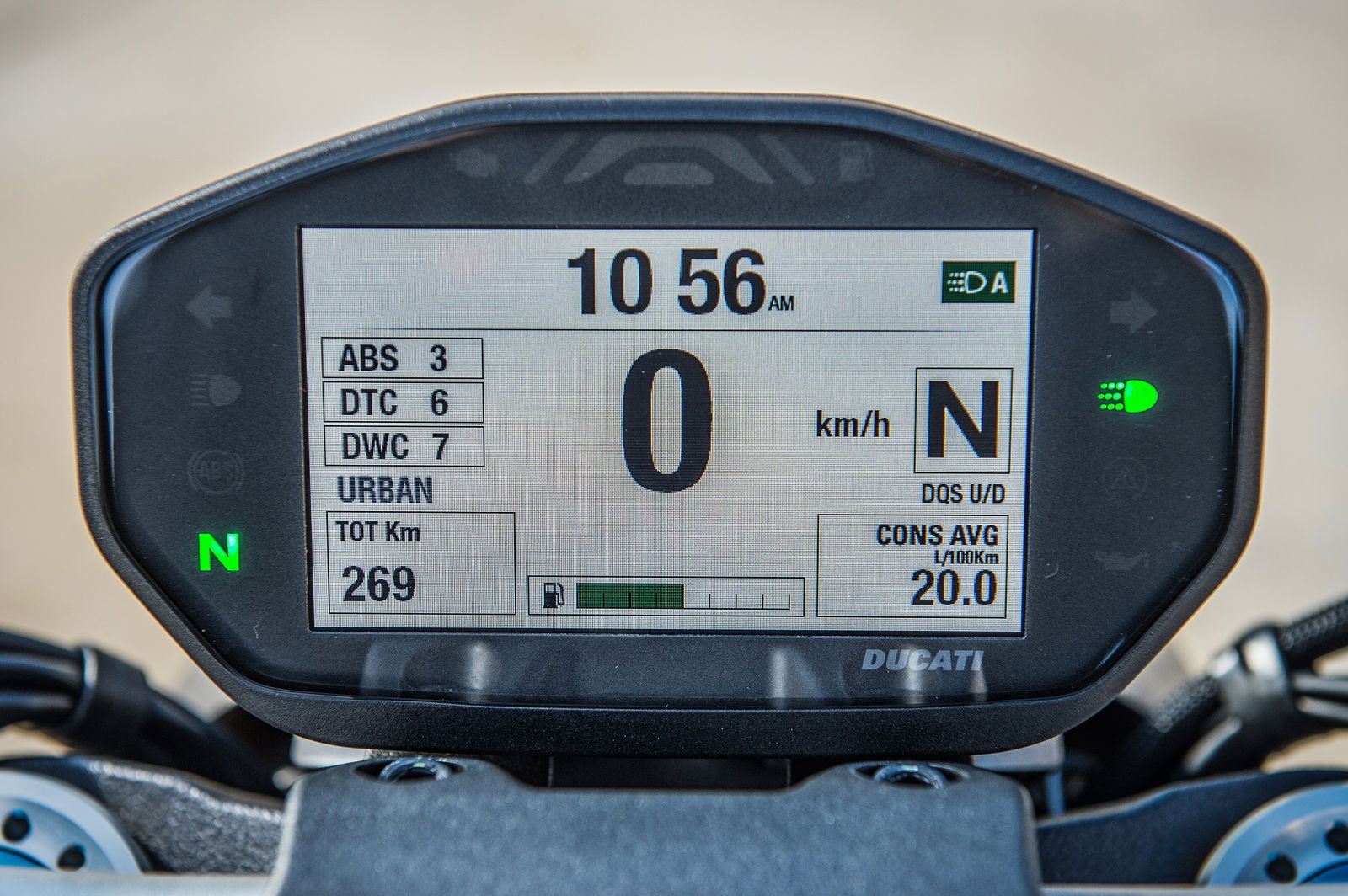
Ducati Monster 1200S (2017): Design
The design is intuitive too. In the pre-ride presentation Ducati recalled one of the marketing hooks from the original Monster: How many bikes can you recognise without being able to see the name on the tank?
Compared to the outgoing model, new Monster might have a narrower, smaller capacity 16.5 litre tank (down from 17.5 litres) but I don’t think difference isn’t massively striking and it still retains the muscular, bulbous shape of a tank that is unmistakeably from a Ducati Monster. I found the shape was excellent for hooking in to with my legs on corners.
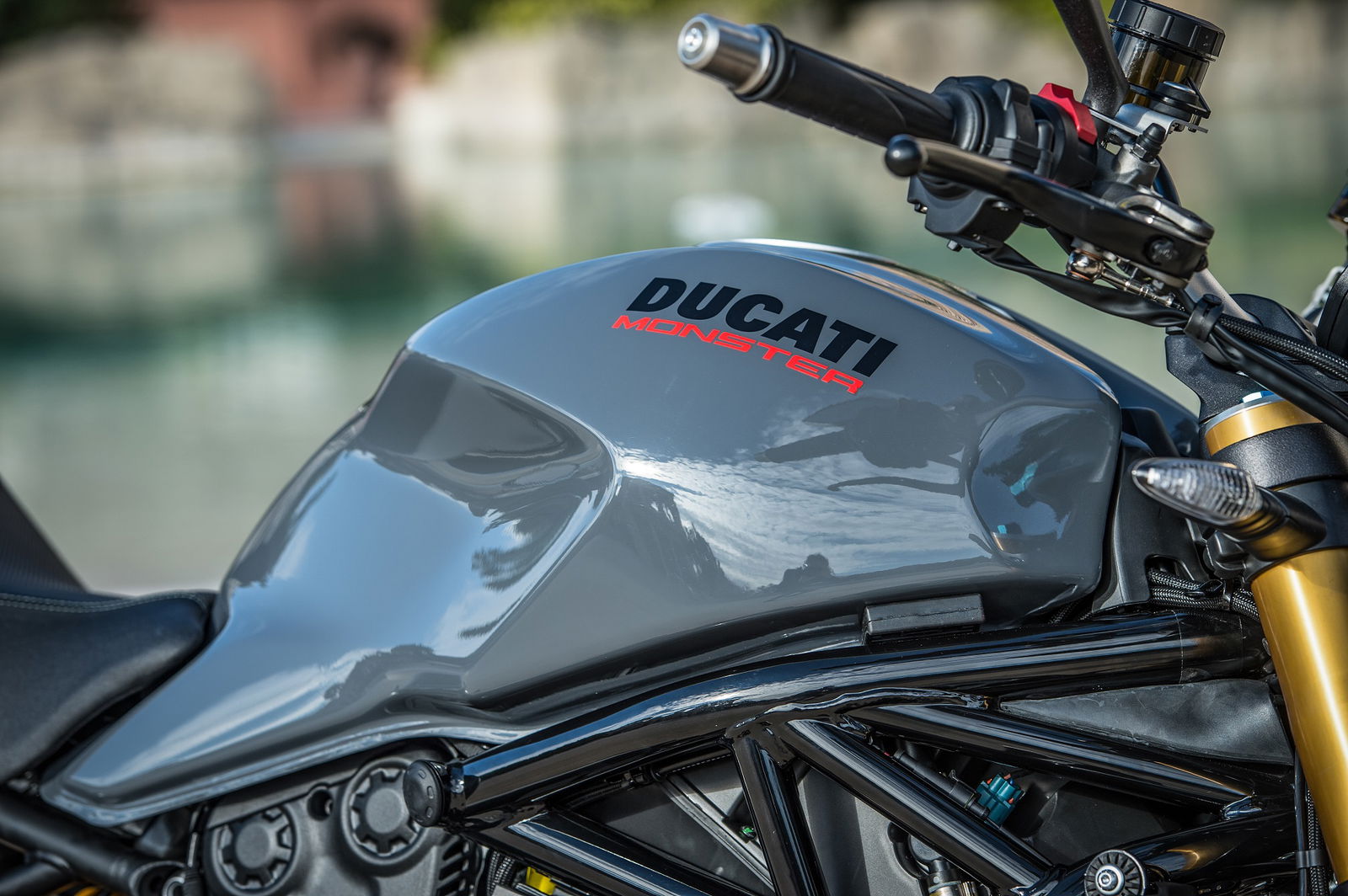
It’s a similar story elsewhere with the new shorter and slimmer tail section, bolted on to a new subframe. The light, with LED daytime running light for the S, is also new. It’s not radical change, but a bit of modest refinement that, with the carbon front mudguard and graphics on the S-specific wheels, subtly enhances the bike.

You might have also noticed the exhaust is new too; the two cylindrical silencers of the previous 1200S have been replaced by chunkier stainless steel silencers from the Monster 1200 R and there’s an additional catalyser too, which with the help of some mapping changes, ensures the engine conforms to Euro 4 standards.
Considering it’s a victim of Euro 4 legislation, it sound alright. It might lack some of the low-end boom and rumble of an older Monster 1100 on a set of fruity set of cans but the standard exhaust tickled my eardrums enough. Its aural aptitude was definitely when off the throttle and on the brakes, approaching one of the 3,179 hairpin bends on the test route, the twin silencers would emit a subtle but notable burble on the overrun.
Thanks to the auto-blipper, haring into the hairpins was a doddle on the Monster 1200S, but the Brembo M50 monobloc front brakes and 330mm discs certainly help. They’ve got loads of power and there’s excellent feel through the lever. The initial bite isn’t as sharp as what you get from the S1000R or Tuono V4, but the brakes are plenty powerful enough for the road.
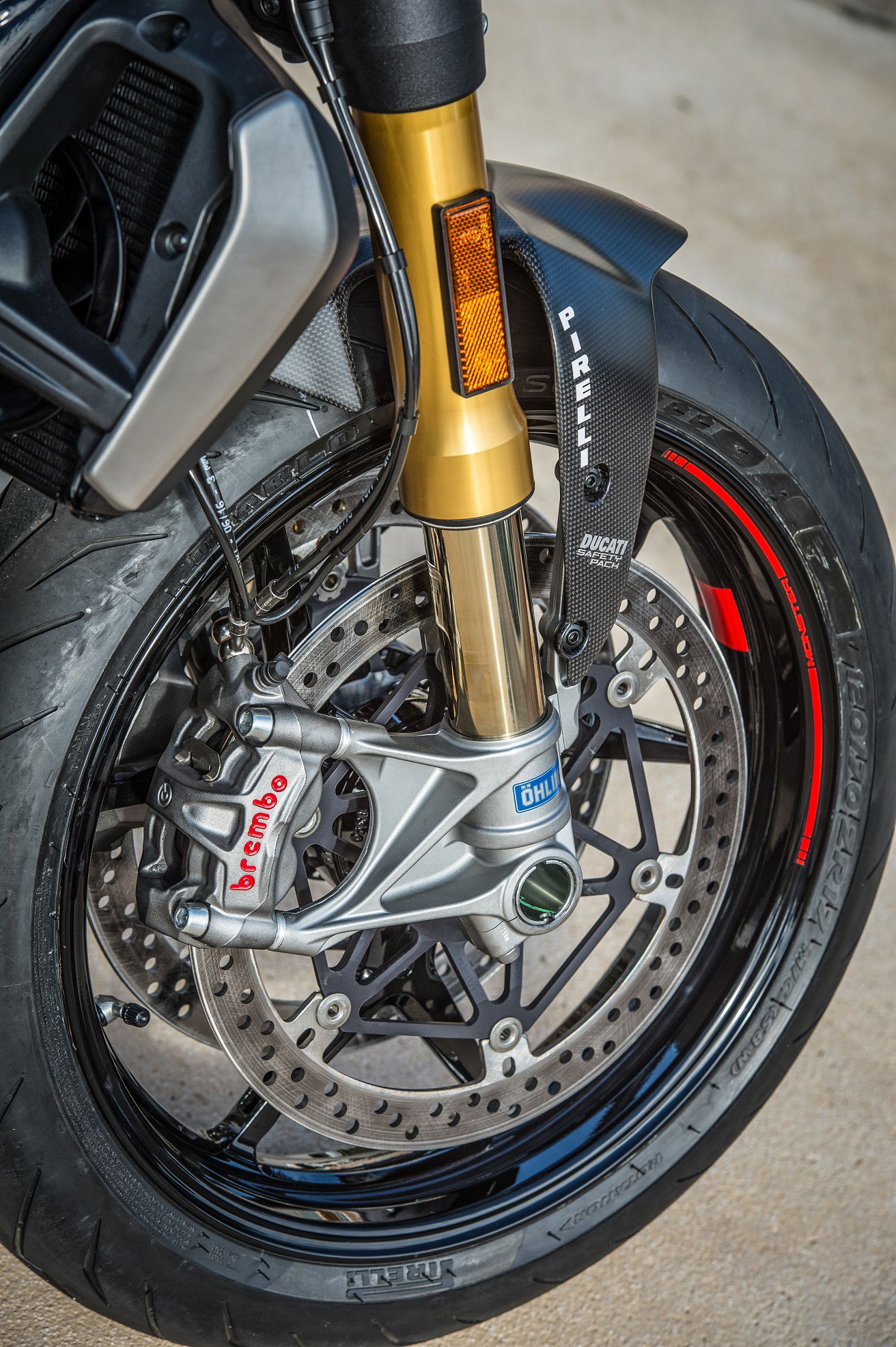
Ducati Monster 1200S (2017): Suspension and Handling
Although the Monster still retains that stocky, brutish aesthetic, it handles with delicacy that isn’t revealed in its looks. Slowing the Monster 1200 S down and readying it for a bend was always a pleasure, not simply because the brakes are good, but because the suspension is sublime too.
The S model I got to ride is equipped with fully adjustable Ohlins all-round and as I’ve come to expect from a bike with the gold bouncy bits, it was very good.
The ride was plush but just the right side of firm. It felt just right for me. The fact it offered loads of support and feel meant that I felt like I could do whatever I wanted coming in and out of bends – it’s precise and planted, and if I dig around in my box of clichés… confidence inspiring. When it came to the back, I felt like I had a decent feel for how much grip I had and there was no issue with comfort.
Although that’s good, at the end of the day, one of the Ducati engineers told me that the bike wasn’t on standard settings. I don’t doubt the fact that standard settings are also likely to be there or thereabouts for many riders, but considering most of these will be ridden away from the showroom on stock settings, I’m a little disappointed that Ducati tweaked the suspension for journalists.
The Monster’s handling manners are helped by a sporty riding position that made me feel like I was sat right over the front wheel. When I first got on, I nearly had to check I hadn’t sat on the tank by accident.
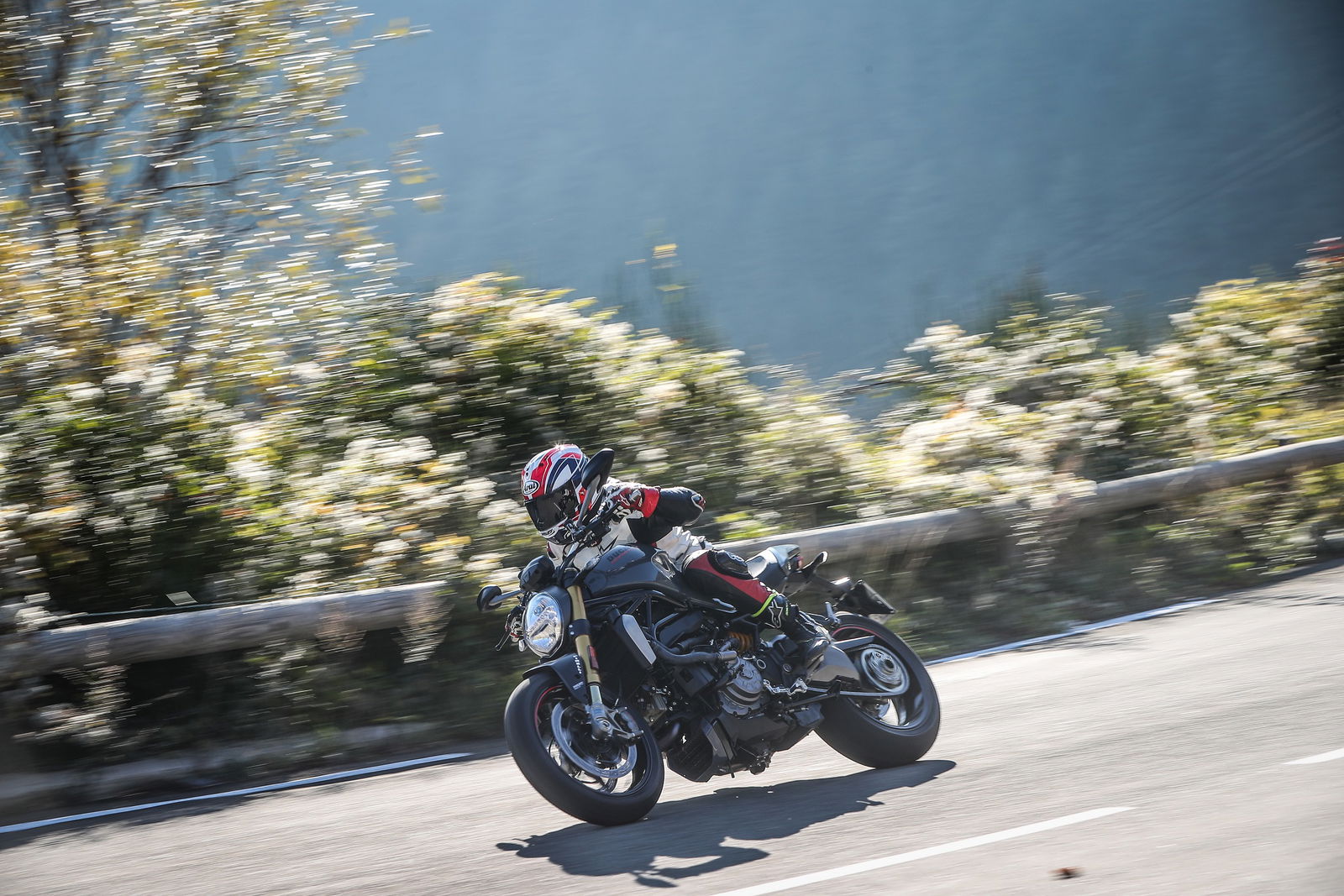
It’s a great riding position and quickly feels natural, helped by a low centre of gravity and a wide set of bars that were occasionally prone to a bit of buzz. I’m not sure it steers as quickly as the BMW S1000R or Aprilia Tuono V4 1100 but in slow, nadgery bends the Monster changed direction with minimal effort. Perhaps the new single-sided swingarm and 26mm shorter 1485mm wheelbase deserves some credit too.
Either way, the Monster 1200S felt light on its feet when negotiating countless tight hairpins and dodging oligarchs in Bentleys in Monte Carlo’s rush hour traffic. Its prowess in a bumper-to-bumper jam would be helped with a little more steering lock – it doesn’t have that much.
And when the pace livens up a bit, the wide bars and aggressive riding position make it easy to lever the monster from side to side in anger along a curvaceous ribbon of road.
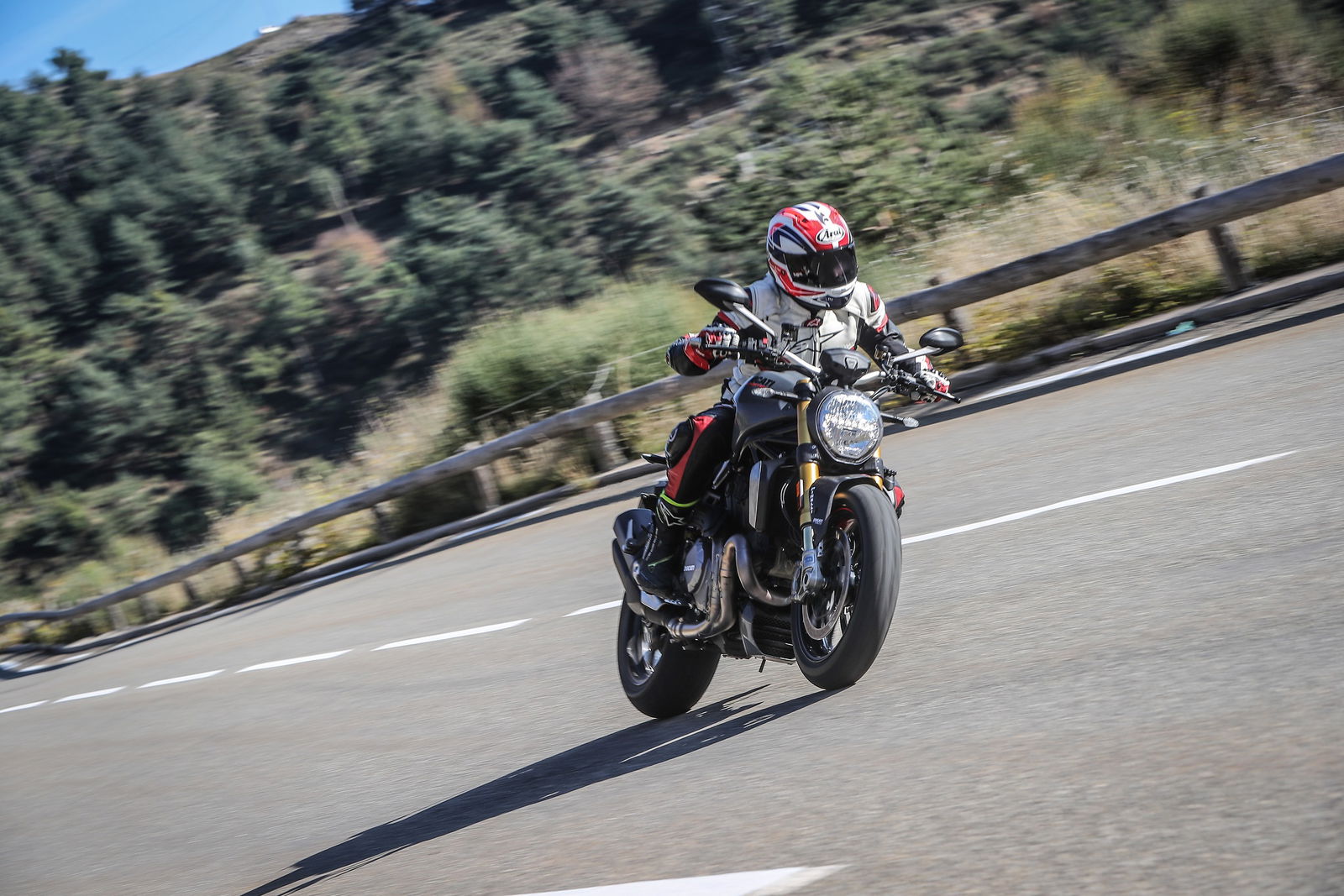
The seat is comfy enough, but nothing to write home about. The seat height is adjustable between 795mm and 820mm and there’s about enough space for a pack of fags under it.
The Monster’s excellent handling is also helped by some decent rubber in the form of Pirelli Diablo Rosso III’s. In the dry they offered heaps of grip and I couldn’t fault them. In the damp they were predictable and gave the bike a confident and stable connection to the tarmac.
Ducati has addressed one of the main criticisms of the previous bike – the hated one-piece foot pegs that make life difficult if you’ve got large feet are now gone and replaced by separate rider and pillion pegs. I haven’t got particularly big feet anyway but on this new bike I found ample space to move my feet round although I think if I had larger feet (I'm a manly size 7), it wouldn't be long before I'd removed the pillion pegs to give myself more room for manouevre. I noticed that after just one day’s riding, my boots had begun to mark the swingarm and exhaust plate.
There are a few other bits that could use some attention, like the slightly faded looking radiator hoses. They should be black but even on my brand-spankers test bike, looked faded and grey. And the fuses – they’re easily found under the right side of the tank, not hidden behind any kind of panel, meaning that any little scrote/a hilarious mate could tamper with them. I’m also not hugely convinced about how effective the rubber fuse covers are likely to be.
Other than a few minor niggles, it’s difficult to find much to fault with the new Monster 1200S.
Ducati Monster 1200S (2017): Price
But what about the price? The standard version with its Kayaba forks and Sachs shock costs £11,495, while the S costs £14,295 in red and £14,495 in grey and comes with Ohlins suspension, Brembo M50 front brakes, a carbon front mudguard, different wheels with unique graphics and a quickshifter as standard.

That’s a fair chunk of money and means the standard Monster is likely to cost more than the recently announced 2017 BMW S1000R. The S model is also more expensive than the £13,999 KTM 1290 Super Duke R but doesn’t quite match it in terms of performance and if you’re the kind of rider looking for a lunatic naked bike, the cheaper KTM is likely to be more a tempting prospect, and the same could be said for the slightly more costly Aprilia Tuono V4 1100 RR. The Triumph Speed Triple R is also cheaper at £11,900 – and for that you get Ohlins and Brembo parts too.
And then there’s the Monster 1200R, which costs £15,550. Although it’s got 10hp more than the new 1200S, for some the S’s lower price and more comprehensive electronics are sure to make it a more tempting proposition against the taller, more track-biased 1200R.
Should I buy the Ducati Monster 1200S (2017)?
So I’ve finally ridden a Ducati Monster and I’m content that it was the new 1200S. But is it still 'unmistakably Monster'? The new 1200S might not be the minimal air-cooled bike from the early '90s but it looks like a modern day Monster should and pays homage to the essence of those original models with the fun, accomplished and exciting ride on offer. Alright, the barebones simplicity of the older models is gone but the Monster 1200 S's technology and top spec components come together to create a package that's hard to fault. I wouldn't want to have broken my Monster cherry on anything else (well, except for the original).
Ducati Monster 1200S (2017): Specifications
- Tested: Ducati Monster 1200 S
- Price: £14,495 (or £14,295 in red)
- Engine: 1198.4cc Testastretta 11° liquid-cooled L-twin
- Power: 150hp at 9,250rpm
- Torque: 93.1lb/ft at 7,750rpm
- Suspension: Front - Ohlins 48mm full-adjustable upside down fork / Rear – Fully-adjustable Ohlins monoshock
- Brakes: Front – Twin Brembo M50 monobloc calipers and 330mm semi-floating discs / Rear – Single two-piston caliper and 245mm disc
- Weight: 185kg dry / 200.5kg wet with no fuel
- Tank capacity: 16.5 litres
- Seat height: 795mm - 820mm

